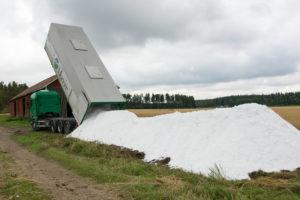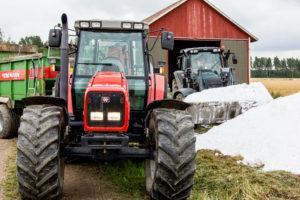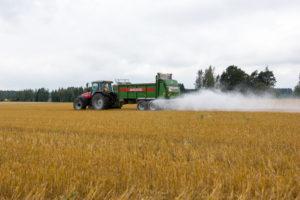Benefits
Gypsum application of fields is a rather new, effective, and promising measure to reduce phosphorus (P) and suspended solid loads from agricultural soils. According to scientific research, gypsum reduces both particulate and dissolved reactive P loads. The total phosphorus reduction may be as high as 30% in catchment areas. However, the practical experience of this measure is still lacking, especially at large scale.
Objectives and activities
Pilot Gypsum assesses the efficiency, social acceptance and practical applicability of the method by organising a pilot in the Finnish Archipelago Sea catchment area. The pilot can be divided into two phases: the operational and the analytical/post-operational.
In autumn 2016 more than 1,500 hectares of clay fields were treated with gypsum in the catchment area of river Savijoki, in South-Western Finland. With 4 tons per hectare, a total of 144 truckloads of gypsum were transported from Yara’s factory in Siilinjärvi to the pilot area. This operational phase, and its careful planning, was carried out in a close collaboration with the local farmers, agricultural supply store Hankkija, logistics company Movere, gypsum supplier Yara and local contractors.
During the post-operational phase, the impacts on water quality are monitored and analysed by Finnish Environment Institute. The monitoring is done with automatic measurement systems and with manual sampling. Furthermore, outlines for a large scale implementation of the procedure in Southern Finland are drawn. This plan provides information on the potential arable clay land areas, logistics, and other relevant issues. How gypsum could be included in the Finnish Agri-Environmental Scheme will also be considered.
As a part of this work, also the applicability of this method to other Baltic Sea countries will be discussed. Altogether, the pilot aims to increase the general awareness of gypsum by communicating the pilot results at local, national and international level.
Implementation
University of Helsinki is responsible for implementing the pilot. In the NutriTrade project, gypsum application is piloted and developed as an innovative method for the Baltic Sea protection. The results are also utilised in development of the NutriTrade platform. The pilot is connected also to the project SAVE (Saving the Archipelago Sea by applying gypsum to agricultural fields), financed by the Finnish Ministry of Environment. SAVE is a joint research project of University of Helsinki and Finnish Environment Institute and conducts research (impacts on water, soil, crops and social acceptance) related to the pilot. Further information about gypsum application and related research are found also from the web page of SAVE project.



